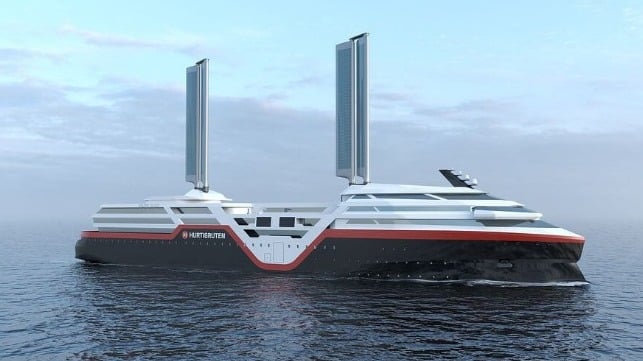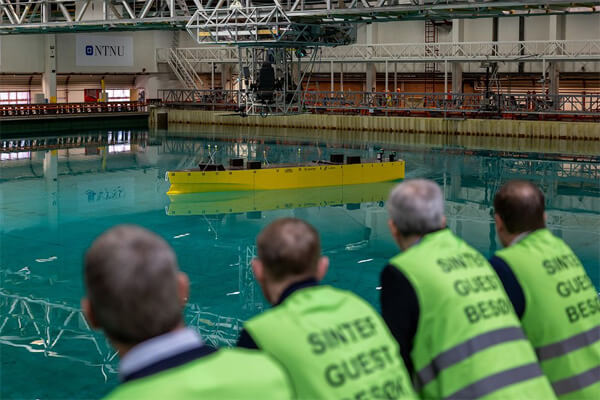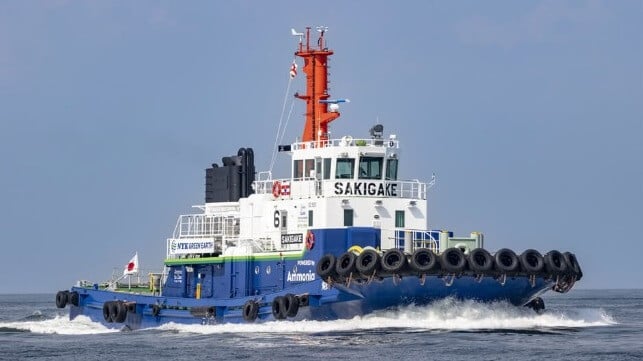ALT. FUELS
Model Testing Advances Hurtigruten’s Design for Sustainable Cruise Ship

Two years after previewing the Sea Zero project to develop the world’s most energy-efficient cruise ship, Hurtigruten and its partners report the design has been refined through a series of model tests. Hurtigruten wants to design a ship that can sail without emissions in normal operation on the Norwegian coast from around 2030.
The project reports it completed a new phase of rigorous testing using digital simulations and physical trials in Trondheim, at the Norwegian research institute SINTEF Ocean’s facilities. In addition, Vard Design, DNV, Brunvoll, Plug, Corvus Enegery, and others are also participating in the project. Involving the partners, the recent testing worked to evaluate large battery packs, retractable sails, air lubrication systems, contra-rotating propellers, and an energy-optimized hull.
“We are learning a lot from these tests, and we now see that many of the ambitious goals in this project can also be implemented in practice,” said Gerry Larsson-Fedde, Chief Operating Officer at Hurtigruten.
Following months of design work and testing, they report the ship design has been further refined. The ship is now eight meters longer (143.5 meters/471 feet total) and slightly wider than earlier versions of the concept. The height has also been reduced by one deck to among other things provide better stability. The design has been reduced from three to two retractable solar sails.

Model testing is helping to refine the design (Hurtigruten)
The Sea Zero concept aims to cut energy between 40-50 percent compared to today’s ships. The companies report that the sails alone could reduce energy consumption by 10 to 15 percent. With that reduction, they report that batteries charged with shore power connectivity in key ports could make emission-free operations possible.
"With the reduction in energy use we’re aiming for, it’s realistic to fit a battery system with enough energy to allow the ship to sail between charging ports under normal weather conditions," said Trond Johnsen, Project Manager for Sea Zero.
Committed to setting a higher standard for more sustainable travel initiatives, Hurtigruten highlights that its fleet currently includes four battery-hybrid powered ships, while it also prioritizes energy efficiency and responsible waste management. Through the ambitious Sea Zero project, Hurtigruten aims to develop its first ship that can sail emissions-free in normal operations on the Norwegian coast and in response to Norway’s tightening regulations for shipping emissions.
Norway’s Parliament last year finalized rules setting a phased-in schedule to move coastal shipping and vessels operating in the fjords to zero emissions. Cruise ships and ferries under 10,000 gross tons will have to operate with zero emissions by January 1, 2026. For the large ships, the implementation is scheduled for January 1, 2032.
First Ammonia-Fueled Tug Completes Three Months Demonstrating GHG Reduction

The world’s first commercial-use ammonia-fueled vessel, Sakigake, completed a three-month demonstration voyage. Engaged in tugboat operations in Tokyo Bay, NYK which owns the vessel reports it achieved a GHG-emission reduction of up to approximately 95 percent. They believe it illustrates the potential of ammonia as a maritime fuel.
The 272-ton tug Sakigake, which was built in 2015 as Japan’s first LNG-fueled tug, was selected for the pioneering project. When it was introduced a decade ago, the tug which is 122 feet (37 meters) in length was viewed as a proof of concept for alternative fuel operations in the class. It is again taking that role for ammonia-fueled propulsion.
The conversion program for the vessel was completed by Nippon Yusen Kabushiki Kaisha (NYK) and IHI Power Systems Co. on August 23, 2024. They worked in cooperation with Nippon Kaiji Kyokai (ClassNK) as part of a Green Innovation Fund Project sponsored by Japan’s New Energy and Industrial Technology Development Organization (NEDO).
The development project of this vessel started in October 2021 as part of NEDO’s Green Innovation Fund Project which provided for the “development of vessels equipped with domestically produced ammonia-fueled engines.” The companies worked together to develop the designs and ultimately removed the LNG-fueled propulsion system to replace it with the new ammonia-fueled propulsion. Sakigake became the world’s first commercial-use ammonia-fueled vessel following Fortescue which converted an offshore support vessel and completed certification for its ammonia system earlier in 2024.
NYK Group company Shin-Nippon Kaiyosha operated Sakigake in a three-month demonstration voyage while conducting tugboat operations in Tokyo Bay. NYK and IPS analyzed the ammonia co-firing and GHG-reduction rates during vessel operations and confirmed it consistently exceeded 90 percent. Depending on engine load rates, they were also able to achieve a 95 percent reduction in GHG emissions.
After having completed this first demonstration, the vessel will continue to be used for tugboat operations in Tokyo Bay. NYK reports it will continue to accumulate knowledge related to the development and operation of ammonia-fueled vessels.
NYK, Japan Engine Corporation, IPS, and Nippon Shipyard Co. are working together to develop an ammonia-fueled ammonia gas carrier, which is scheduled to be delivered in November 2026. This project is also sponsored by NEDO’s Green Innovation Fund Project and is part of NYK’s efforts to develop and introduce next-generation fueled vessels.
No comments:
Post a Comment